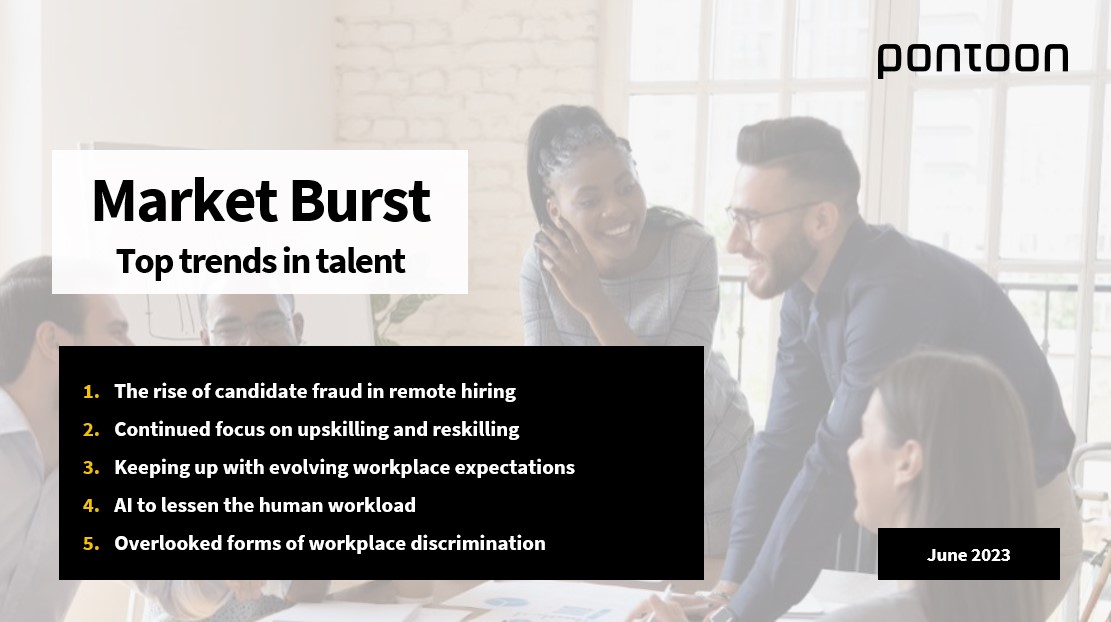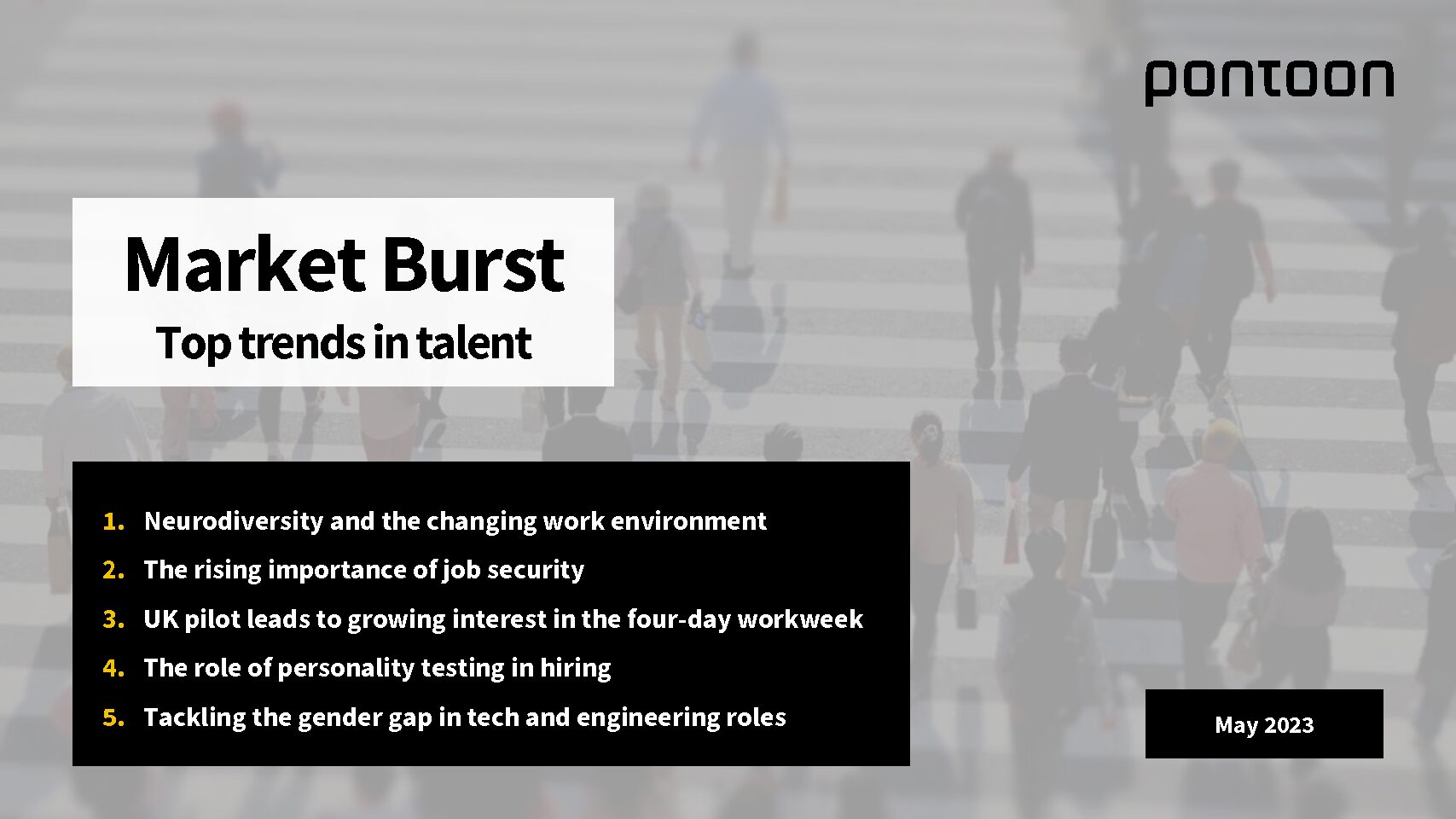Market Burst: June 2023
Read about top trends in the world of work.
In this month’s instalment of our Market Burst, we analyse the trends that continue to drive talent management in the evolving workspace. These include the rise of candidate fraud in remote hiring, continued focus on upskilling, AI enhancing human productivity, and more.
The rise of candidate fraud in remote hiring
As companies continue to adapt to remote hiring, there has been an increase in fraudulent behaviour during online interviews and evaluations. Studies report a 92% increase in candidate fraud. Dishonest tactics such as plagiarism, submitting someone else’s work as their own, and enlisting external assistance during video interviews are all too common. The repercussions of hiring a fraudulent candidate can be severe. It can harm organisational reputation, financial status, and even employee safety.
To avoid these pitfalls, employers must remain vigilant and implement measures to prevent and identify such fraudulent behaviour. Leaders should adhere to best practices in spotting candidate fraud and consider investing in AI technology for additional security.
AI technology can be an invaluable tool for employers to mitigate the risk of fraudulent activity during remote interviews. AI-enabled tools can confirm candidate identities and monitor video and audio feeds to record signs of cheating and “red flag” suspicious behaviours. Employers can also use machine learning tools to detect subtle changes in body language, speech patterns, or response inconsistencies, which can identify dishonest candidates.
Businesses that do not verify their candidates or screen for fraudulent activity expose themselves to severe consequences, such as possible financial crimes within their organisation.
“By leveraging AI technology, corporations can deter and prevent fraudulent applicants while improving quality and speed. The technology can monitor every aspect of a candidate assessment while determining skill level, allowing businesses to engage talent more productively.” – Maran Henderson, Director Financial Services, Pontoon
Continued focus on upskilling and reskilling
With the rapid evolution of the job market towards technology-intensive industries, upskilling and reskilling have become critical for bridging the existing skills gap in Europe. Data from the European Commission reveals that 77% of EU companies struggle to source skilled employees, while only 54% of workers in the region have basic digital skills.
European employers must commit to professional development to retain and attract workers equipped for the digital future. The European Year of Skills 2023 seeks to address this issue and support companies through collaboration between public employment services and the private sector, along with encouraging corporate investment in workers’ upskilling.
At Pontoon, we fully support the professional development of both our own people and our clients’ talent. We encourage colleagues to set up learning goals and develop through outcome-based training, and we collaborate with customers to design skills academy programmes for their existing workforce. As part of our advisory service – Pontoon Instinct – and specifically within the ESG & Impact practice, we help our clients realise that investing in upskilling and reskilling brings great returns in employee engagement, allowing them to prepare for the future of work.
Keeping up with evolving workplace expectations
Businesses must adapt to workers’ changing expectations concerning their work environment. Flexibility is still crucial for most people, and firms respond by implementing hybrid work schedules. According to reports, 82% of companies now have a hybrid work policy in place, and many are looking to attract more workers back to the office. Almost 3 in 10 employers said that food and beverage programmes topped the list of workplace incentives in 2022, followed by in-person corporate social events. Office spaces are also preferred for teamwork, and 23% of leaders plan to invest in physical collaboration tools in 2023. Enhancing corporate facilities with modern technology is essential, as outdated equipment and uncomfortable facilities can discourage in-person attendance.
While firms are encouraging workers to come to the office regularly, it’s important to keep schedules flexible and remote options handy. Personal circumstances, such as caregiving responsibilities or long commutes, should be considered as many employees relocated during the pandemic. Ensuring significant and productive collaboration must be balanced with remote options if companies want to curb retention and drive effective hybrid models.
AI to lessen the human workload
The latest report from Microsoft reveals that 7 in 10 workers would delegate as many tasks as possible to AI to reduce their own workload. This is quite a big revelation given that concerns over AI replacing jobs remain commonplace across industries. Even more interestingly, people would be comfortable with the tech supporting non-administrative tasks, such as analytical (79%) or creative work (73%). The same report reveals that AI has the biggest potential to save time and enable smart work. Unsurprisingly, business leaders are 2x more interested in using tech to increase productivity rather than to cut headcount.
At Pontoon, we have recently analysed the potential of AI to support talent acquisition. The technology can help with enabling targeted communication across social media and online platforms, as well as with automating tests and video interviews. It can also support effective demand planning in contingent hiring or speed up the onboarding of contingent workers.
Given the potential of AI, it’s crucial for firms to equip their workers with the knowledge necessary to operate – or collaborate with – artificial intelligence. Equally important is to consider how roles and functions will evolve alongside AI, and how technology will accelerate workers’ productivity.
Overlooked forms of workplace discrimination
Workplace discrimination comes in various forms, and while a lot of focus has been placed on gender or age, there are other forms of inequity functioning in places of employment. Physical appearance bias, including clothing style, weight, or hair, is frequently overlooked in corporate diversity, equity, and inclusion (DE&I) strategies. To create a culture of complete inclusivity, firms must be acutely aware of all potential grounds for discrimination.
It is important to understand that physical appearance often correlates with adverse judgments about an individual’s professional competence. For example, a recent study reveals that people of a more conventional build are viewed as industrious and hard-working, while workers that don’t fit the social norms regarding weight are more likely to be labelled as unmotivated. Interestingly, 11% of HR professionals admitted that a candidate’s figure impacts their company’s decision-making during the hiring process. Another report showcases that Black women’s hair is two-and-a-half times more likely to be perceived as unprofessional at work, and two-thirds of women of colour said that they had changed their hair for a job interview to appear more trustworthy.
Rooted in cultural norms, such stereotypes diminish people’s chances of securing a job and advancing in their careers. Additionally, social stigma can detrimentally impact a person’s well-being and easily translate to an increased willingness to leave one’s job. While some steps are being taken to counteract discrimination based on physical appearance – including legislation issued last month by the New York City Council – a lot remains to be done. Businesses must instruct recruiters, hiring managers, and peers about the overt and covert biases that fuel different forms of discrimination. By taking a stand and creating a welcoming and accepting culture, firms can prevent the loss of valuable workers and attract more talent.
Related Post
Read about top trends in the world of work.
In this month’s instalment of our Market Burst, we dive into the trends that continue to drive talent management in the evolving ...





